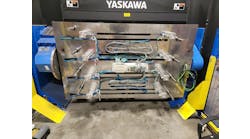Automation is the future of logistics
The global warehouse automation market is estimated to grow at a compound annual growth rate (CAGR) of 14%, reaching $30 billion by 2026. The number of OEMs and system integrators who are trying to grow their business by serving more logistic customers is growing year by year.
Omron has more than 80 years of history of supporting manufacturing automation by offering key solutions such as sensing, automation control system, machine vision, safety and robotic. One of the top challenges for manufacturers has always been handling the products and materials with high accuracy while maintaining high throughput.
The evolution from manufacturing automation to warehouse automation demands similar operational efficiency and throughput, yet the nature of unknown objects (for example eCommerce orders) adds extra layers of complexity.
Warehouse operations involve labor-intensive processes, but where are the labor resources?
The current labor shortage and the high cost of hiring skilled workers have dramatically impacted the logistics industry, particularly at a time when the increasing popularity of customization is making it a challenge to predict customer demands. Customization adds complexity for warehouse workers to handle different products from multiple suppliers. It’s difficult for workers to operate at high speeds while maintaining accuracy throughout a more cumbersome process. Warehouses need more workers, but they simply can’t find them, and training will take away time from the existing skilled workers.
How can warehouses deal with the unperceptive changes of customer demand and ensure maintain the throughput time and the cost as well as optimize space is critical. Although warehouse automation requires more advanced technology developments and high upfront investment, the results from these initiatives are usually highly flexible and repeatable. The general process usually starts from inbound to storing then to picking and sorting then eventually go to outbound. The labor time in the warehouse was mostly spent on picking followed by searching. Automation can help to save time by taking away the non-value-added steps in the process such as walking to pick items.
Three robotic order picking solutions that can ease logistics challenges
- Goods2Person picking solution. Many companies have invested in automated storage and retrieval system (AS/RS) to save space and increase inventory traceability in their warehouses. As such, a Goods2Person (G2P) picking strategy is usually applied. In this scenario, an autonomous mobile robot (AMR) can interact directly with the AS/RS system to bring totes or storage shelves to a designated location where a warehouse associate will collect them and move on to the next step. The AMR-cobot combo (also known as a “mobile manipulator” can pick items from multiple shelves and then return to a designated location where a warehouse associate will collect them and move on to the next step.
- Follow me robotic order-picking solution. In the case of a traditional setting, a warehouse uses static shelves such as pallet shelves. The workers usually need a cart or totes to collect items during the picking process. This solution can help to assist human workers to pick and move items around the warehouse by applying a zone-picking strategy. The mapping and navigation function in a mobile robot allows workers to teach the robots to perform tasks depending on warehouse needs and space settings.
- Fully automated order picking solution. This solution combines the AMR and cobot with 3D vision and artificial intelligence (AI) to achieve complete non-human operation.
As mentioned above, customers want customized products to arrive without delay, and they want their orders to be fully accurate. A robotic solution that incorporates traceability elements can improve the pick-and-place process to satisfy rapidly changing customer demands.
Traceability ensures accuracy
A barcode reading system is important for tracking the accuracy of pick-and-place. AI-enhanced 3D vision systems can perform automated inspections to verify the standard quality of the product. These technologies can be integrated into a streamlined, easy-to-implement system.
Historically, traceability was implemented with barcodes that were printed on paper-based labels. These unfortunately were prone to getting worn out or washed off over time, so workers needed to check frequently to make sure the labels were still present. When replacing a label, the new one would have to be consistent with the previous one to ensure accurate reading of the label information.
For multi-side code reading, Omron presents an innovative scan tunnel solution that uses industrial cameras in converse to smart cameras. This approach separates image acquisition and processing devices and creates architectural flexibility and lower overall solution costs.
However, in some industries such as apparel, code reading can be very challenging, as it’s difficult to always ensure the labels face outside of the product package. To avoid such issues relating to missing labels or those with inconsistencies, many warehouses have adopted RFID technology in the place of printed barcodes. This offers peace of mind that no label loss or misprint will occur. Over time, RFID helps drive down the total cost of ownership by removing non-value-added tasks.
Overcoming space-related issues
The next challenge that the logistics industry needs to solve is limited space. The automated storage system optimizes space usage by using robots that can easily perform tasks within a narrow area or on high shelves that humans can’t reach. Omron’s sensing and automation control systems are being used by leading AS/RS manufactures for our high-quality products and easy-to-use programming platform Sysmac.
By saving space, increasing flexibility, and reducing the dependence on labor resources, intelligent automation solutions can help companies in the logistics arena thrive. As fully integrated automation technologies become easier and easier to implement, we’re likely to see more companies jumping on the bandwagon and finding ways to optimize their processes with collaborative and mobile robotics.





